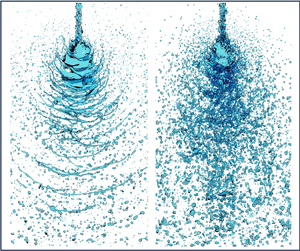Article contents
Turbulent atomisation of impinging jets under rising backpressure
Published online by Cambridge University Press: 14 January 2025
Abstract

This study employs direct numerical simulations to examine the effects of varying backpressure conditions on the turbulent atomisation of impinging liquid jets. Using the incompressible Navier–Stokes equations, and a volume-of-fluid approach enhanced by adaptive mesh refinement and an isoface-based interface reconstruction algorithm, we analyse spray characteristics in the environments with ambient gas densities ranging from 1 to 40 times the atmospheric pressure under five different backpressure scenarios. We investigate the behaviour of turbulent jets, incorporate realistic orifice geometries and identify significant variations in the atomisation patterns depending on backpressure. Two distinct atomisation types emerge, namely jet-sheet-ligament-droplet at lower backpressures and jet-sheet-fragment-droplet at higher ones, alongside a transition from dilute to dense spray patterns. This variation affects the droplet size distribution and spray dynamics, with increased backpressure reducing the spray's spreading angle and breakup length, while increasing the droplet size variation. Furthermore, these conditions promote distributions that induce rapid, nonlinear wavy motion in liquid sheets. Topological analysis of the atomisation field using velocity-gradient tensor invariants reveals significant variations in topology volume fractions across different regions. Downstream, the droplet Sauter mean diameter increases and then stabilises, reflecting the continuous breakup and coalescence processes, notably under higher backpressures. This research underscores the substantial impact of backpressure on impinging-jet atomisation and provides essential insights for nozzle design to optimise droplet distributions.
JFM classification
Information
- Type
- JFM Papers
- Information
- Copyright
- © The Author(s), 2025. Published by Cambridge University Press
References
- 5
- Cited by


